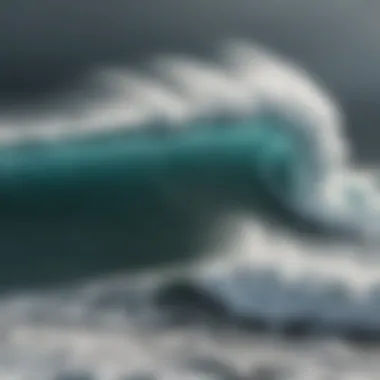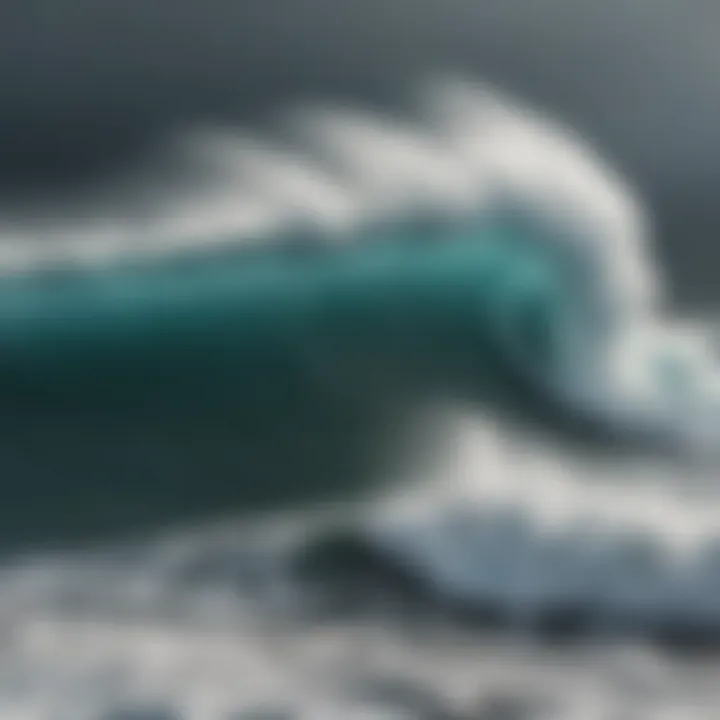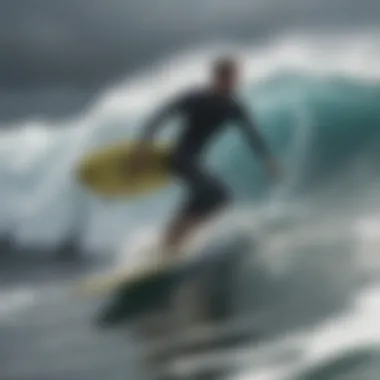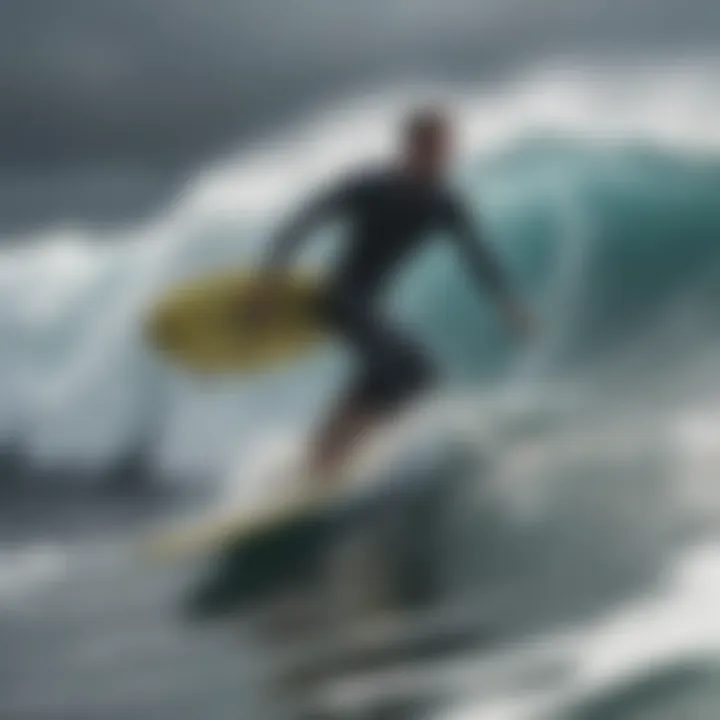Navigating Waves: A Deep Dive into Storms and Surfboards


Intro
When it comes to the exhilarating world of surfing, understanding how storms shape the waves can be the difference between an unforgettable ride and a risky venture. Wave storms, with all their chaotic energy, produce some of the most sought-after surfing conditions. However, for the unprepared, they can also pose serious dangers. Throughout this article, we will peel back the layers on how these storms affect the ocean, the right surfboards to tackle various conditions, and the skills you need to stay safe while navigating turbulent waters.
Equipped with this knowledge, surfers at any skill level can better appreciate the dance between nature and sport. From beginners to seasoned pros, everyone has something to gain from mastering the science behind waves and their unpredictable moods.
Techniques and Skills
Fundamental Techniques for Beginners
Starting on your surfing journey requires mastering the fundamentals. First and foremost, learning how to paddle effectively is crucial. Paddling gets you into position to catch waves, so practicing a smooth, strong stroke can make all the difference. Positioning is also key—make sure to sit far enough out to catch the swell but close enough to avoid exhausting yourself before the wave arrives.
Another vital skill is the pop-up. This is the move that transforms you from lying on your board to standing tall as you ride the wave. Begin with small surfboards in calm waters to build confidence before moving into stormier seas.
Advanced Skills for Experienced Athletes
Once you're comfortable catching smaller waves, it’s time to refine your abilities and tackle more challenging conditions. Advanced surfers might focus on reading the wave. This involves understanding how the wave forms, where it peaks, and how to predict its breaking point. This knowledge allows surfers to position themselves optimally for the perfect ride.
Moreover, mastering maneuvers such as bottom turns, cutbacks, and aerials can significantly enhance performance in storm-driven waves. Equally important is developing a sense of fluidity and adaptability in your movements; every wave is unique, especially in changing storm patterns.
Safety and Gear
Essential Safety Measures in Watersports
Safety in surfing cannot be overstated, particularly in stormy conditions. Here are a few non-negotiable safety practices:
- Always surf with a buddy. There’s strength in numbers.
- Know the local weather predictions. Storms can switch up conditions fast and leave you in a tight spot.
- Stay aware of your environment. Rocks, currents, and other surfers can pose unseen dangers.
- Wear appropriate gear. Wetsuits, helmets, and impact vests—not just for show!
"Remember, the ocean is not just your playground but also a powerful force of nature that demands respect."
Gear Reviews and Recommendations
Choosing the right surfboard is essential, especially as conditions change. Here’s a quick run-down of recommended boards based on the type of conditions:
- Shortboards are preferred for performance in bigger waves. They offer maneuverability, which is key in turbulent water.
- Longboards work well for beginners and smaller waves, providing stability as you hone your skills.
- Fish boards are a hybrid that can handle new and challenging conditions. Their unique shape allows for speed and control, especially in choppy surf.
For gear reviews, check platforms like Reddit or surf-specific sites for real user feedback. You can also explore social media pages dedicated to water sports for brands and latest tech releases.
As you gear up for your next adventure, remember to always keep learning and stay aware of the ocean's moods—it might just make your experience all the more rewarding.
Prologue to Wave Storms
Understanding wave storms stands as a pivotal element in the surf culture and the broader oceanic discourse. These meteorological phenomena don’t merely dictate the mood of the sea; they shape the very essence of the surfing experience itself. Wave storms bring about powerful and dynamic changes in water conditions, often transforming familiar coastlines into unpredictable terrains. Recognizing the various facets of wave storms can significantly enhance one's surfing skills and safety awareness.
When surfers talk about wave storms, they often think of thrilling rides and massive waves. But there is much more to it. These storms serve as harbingers of change, altering wave dynamics, currents, and even affecting long-term coastal erosion. To surf efficiently during or after a storm, you first must grasp the nature of these waves and what causes them.
Definition of Wave Storms
Wave storms represent a category of intense oceanic events characterized by the rapid formation of waves due to strong wind conditions, typically over vast expanses of the sea. In essence, these storms generate waves that are greater in both height and energy than standard sea conditions, making them far more challenging for surfers.
How Wave Storms Form
Role of Wind Patterns
Wind patterns, often influenced by varying climatic conditions, play a crucial part in wave storm formation. When winds blow consistently over ocean surfaces, they transfer energy to the water, creating waves. During a wave storm, wind speed and duration increase significantly, leading to larger, more powerful waves. A key characteristic of wind patterns in these storms is their intensity; heavy winds often whip up surf that can reach remarkable heights. Stronger winds can cause waves to break far from shore, setting the stage for thrilling—yet precarious—surfing conditions.
Another unique feature of wind-related wave storms is their tendency to create swells. These swells can travel long distances, arriving at coastal areas with increased energy. This allows surfers to experience waves much larger than those typically found in calmer waters, although they come with varying degrees of risk and reward.
Oceanic Currents and Temperature
Oceanic currents serve as vital components in the formation of wave storms, impacting the speed and direction of water flow. Currents influenced by temperature differences can either amplify or reduce wave intensity, contributing to more complex wave patterns. Warm water can lead to the expansion of air above it, creating low-pressure systems that further drive storm progression.
A notable feature here is how temperature serves as both a driver and an inhibitor. While warm waters can generate stronger storms, cold temperatures can stabilize the atmosphere, potentially minimizing the storm's impact on wave conditions. Surfers need to consider these oceanic interactions, as understanding them can provide vital clues about upcoming surfing conditions.
Seasonal Variations
Every season brings a different flavor to wave storms. During certain periods of the year, like winter, storms become more frequent and intense in specific regions. These seasonal variations come with distinct weather patterns and oceanic conditions that shape the surfing experience.
An important characteristic of this seasonal aspect is predictability: surfers often look for seasonal patterns to determine the best times to hit the waves. With winter often bringing larger swells and summer producing calmer conditions, understanding these cycles can significantly impact a surfer's strategy and choice of locations.
Meanwhile, the unique feature of seasonal variations also includes the unpredictability of storms. While certain patterns may be recognized, exceptional storms can still catch experienced surfers off guard, highlighting the necessity for vigilance and preparedness throughout the year.
Characteristics of Wave Storms
Wavelength and Wave Height
Wavelength and wave height serve as critical indicators of wave storm intensity. Typically, as storm intensity grows, the waves produced also increase in height while the distance between waves, or wavelength, can also change dramatically. Understanding these two characteristics helps surfers gauge the power and potential danger of the waves they are dealing with.
The key point here is that longer wavelengths can mean more energy spread across a wider area, often resulting in smoother rides if timed well. However, this can also lead to unexpected breaks. Surfers must carefully assess both the height and spacing of waves to devise an appropriate approach for tackling stormy conditions.
Frequency and Energy
The relationship between frequency and energy in wave storms cannot be overlooked. Higher frequency of waves often correlates with increased energy levels during a storm. When the energy is concentrated over short intervals, it can lead to powerful and chaotic surf. This characteristic becomes essential for surfers to understand because rapid, high-energy waves can present both exhilarating rides and serious hazards.


Notably, surfers need to consider that while high-frequency waves can be thrilling, they also demand greater skill. Surfers should work on techniques that enhance their ability to handle such conditions, ensuring that they respect the power of nature while enjoying their time in the surf.
Impact on Coastal Regions
The impact of wave storms on coastal areas is significant, shaping the environment in both profound and subtle ways. Storms can lead to coastal erosion, altering landscapes and disrupting habitats for marine life. Not only do these events affect the natural ecosystem, but they also pose serious concerns for human infrastructures, such as homes and piers, along the coast.
A key characteristic of wave storms is their capacity to create long-term changes. For surfers, understanding these impacts becomes essential; aware surfers can better support conservation efforts and engage in responsible surf practices that safeguard coastlines against the erosive power of these storms.
Fundamentals of Surfing
Surfing isn't just about catching waves; it's about understanding the fundamental aspects that make the sport what it is. Getting to grips with these basics is essential for both newcomers and seasoned surfers. This section delves into the history of surfboarding, examines the diverse types of surfboards available, and offers guidance on selecting the right board.
History of Surfboarding
Cultural Origins
Surfing traces its roots back in history, starting with ancient Polynesian cultures. The sport is not merely a pastime but rather an integral part of their cultural identity. The unique feature of these cultural origins lies in the deep spiritual connection these communities had with the ocean. For them, riding waves was a way to establish harmony with nature. This ultimately makes it a rich choice to explore in our discussion, illustrating how integral surfing has become in various societies.
Notably, the use of wooden boards carved from local trees was prevalent among these early surfers. Today, while the modern surfboards have evolved significantly, there remains an appreciation for this historical context that adds depth to the sport.
Evolution of Surfing Techniques
As surfing gained popularity worldwide, techniques began to evolve. Initially, riding waves was quite primitive, dominated mainly by balance. Modern surfing techniques, however, have added layers of complexity, enhancing the rider's performance. For instance, maneuverability has become a key characteristic in competitive surfing, where even the smallest foot adjustment can change the outcome.
This progression signifies a transition from basic wave riding to complex performance art. The unique feature of contemporary techniques is their focus on aerial maneuvers and short, explosive turns. These advancements allow surfers to adapt to varying wave conditions, making it a worthwhile topic for any surf enthusiast seeking to improve their skills.
Modern Surf Culture
Surf culture today has morphed into a global phenomenon that blends sport with lifestyle, embodying freedom and adventure. The distinct character of modern surf culture is its community-driven nature, where surfers bond over shared experiences and common challenges faced in the water.
This community aspect not only fosters a supportive network but also promotes a healthy lifestyle and environmental awareness. Such features are significant in our exploration, as they establish surfing as more than a mere sport; it's a way of life for many. However, the commercialization of surfing can have its downsides, leading to gentrification of surf spots and environmental concerns.
Types of Surfboards
Shortboards
Shortboards stand out for their agility and maneuverability, making them the favored choice for many competitive surfers. Their design allows for quick turns and aerial tricks, fitting well within fast-paced surfing environments. One of the key characteristics of shortboards is their narrow shape, which suits sharper, faster waves. However, they require a degree of skill to master, posing a challenge for beginners.
This scaling of difficulty might deter newcomers, but with practice, many find them rewarding, as they open up opportunities for thrilling performances.
Longboards
In contrast to shortboards, longboards represent a more traditional approach to surfing, providing stability and ease of use. Their length helps beginner surfers feel more secure while riding the waves. This aspect makes longboards a beneficial choice for those just starting on their surfing journey. Additionally, they allow for a range of riding styles, from classic nose riding to smooth gliding.
However, the size of longboards can be cumbersome in crowded surf spots, which is a consideration surfing enthusiasts should keep in mind.
Fish and Fun boards
Fish and Fun boards blend elements of both short and longboards, designed primarily for playful maneuverability in smaller waves. Characterized by their wider noses and tails, these boards have an edge on catching less powerful surf. The unique feature of fish boards makes them an excellent choice for surfers who enjoy a more relaxed pace while still carving through waves.
However, they may lack the precision found in shorter boards, which can be a limiting factor for some advanced surfers.
Selecting the Right Surfboard
Choosing the right surfboard is a significant part of any surfer's journey.
Skill Level Considerations
When selecting a surfboard, understanding skill level is critical. Beginners will benefit from boards with greater stability and buoyancy, such as longboards. In contrast, advanced surfers often prefer shortboards for performance reasons.
This aspect speaks volumes about the necessity of assessing whether the available options align with an individual's ability, fundamentally influencing the overall surfing experience.
Matching Board Types to Wave Conditions
The link between board selection and wave conditions is essential for safe and enjoyable surfing. Each board type has attributes that thrive under certain circumstances. For example, shortboards excel in powerful, steep waves, while longboards shine in smaller swells. Knowing these matchups can prevent accidents and enhance performance, adding layers to both safety and excitement timelines.
Material and Design Factors
Innovations in surfboard materials and designs are ever-changing and crucial when selecting a board. From traditional polyurethane to eco-friendly options like bamboo, these elements affect both performance and environmental footprint.
This consideration opens the door for surfers to reflect not just on their own needs, but also on the broader implications of their choices, again marrying personal preference with cultural consciousness. The key here is finding the right balance to suit individual surfing adventures while promoting sustainability.
Navigating Storm Waves
When we talk about navigating storm waves, we’re not just dipping our toes in some adrenaline-filled sea adventure. It’s an essential aspect of understanding how the ocean behaves during storm events. The waves generated by these storms can be as ferocious as they are majestic, influencing not just the surf conditions but also the safety and efficacy of riding those waves. For surfers, learning to read and respond to these challenging conditions is vital. It’s about harnessing the power of nature while respecting its unpredictable temperament.
Understanding Wave Dynamics
Breaking Waves
Breaking waves are perhaps the most crucial phenomenon when it comes to surfing, especially in stormy scenarios. At their essence, a breaking wave is the moment when a wave's energy overcomes its stability, causing it to collapse and form a surfable crest.
This characteristic is crucial for surfers, as the breaking point indicates where one can catch a wave effectively. A significant advantage of these waves is that they offer dynamic rides, providing the opportunity for aerial maneuvers or powerful turns. However, the force generated can also be intimidating, requiring skill and experience to navigate successfully.


Reef and Beach Breaks
Reef and beach breaks represent different surf zones that offer unique challenges and thrills. Reef breaks occur over submerged rock formations, creating waves that often break with a powerful force and can offer cleaner, more hollow waves. On the other hand, beach breaks occur on sandy bottoms, making them often more forgiving for beginners.
For surfers, understanding where and how these breaks occur can drastically influence their riding experience. Reef breaks may require more precise positioning and timing due to their larger swells and sharper drops, while beach breaks can provide a more varied surfing environment, with different wave sizes depending on the tide and wind conditions. Both offer distinct aesthetics and vibes crystalizing the beauty and unpredictability of surfing.
Barrels and Challenging Conditions
Barrels are those coveted waves that form a hollow tube as they break. Riding inside this tunnel is a pinnacle moment for many surfers, representing both skill and courage. These waves provide an exhilarating rush, but they also come with a demand for high-level prowess in balance and timing.
Barreling waves often arise during storm conditions, as wind and swell align to create powerful, steep waves that are the stuff of legends. The challenge lies in the risks that these waves pose; they can easily throw off even experienced surfers, shifting their balance or dragging them into the depths of the turbulent waters.
Techniques for Surfing in Storms
Positioning and Timing
Positioning and timing are essential skills when it comes to surfing storm waves. Knowing where to be before a wave breaks can define the difference between a ride to remember and a wipeout that shakes your confidence. Surfers need to train their instincts to gauge the swell pattern and crowds, strategically positioning themselves to capitalize on incoming swells.
This skill is ever-evolving, with no one formula fitting every situation. The ability to read the ocean and anticipate its rhythms comes from practice. Essentially, positioning is about fighting against chaos while timing is about embracing the essential moment of wave growth, culminating in a thrilling ride.
Choosing the Right Line
Choosing the right line can make or break a surfing experience, especially in turbulent storm conditions. It involves selecting the trajectory for riding a wave, incorporating not just personal style but also practical considerations induced by the wave’s behavior.
Other surfers might opt for a more conservative line toward safety, whereas more seasoned individuals might push the boundaries further out into the storm’s mouth. The risk and reward of this decision can significantly influence a surfer's experience, from the joy of a solid ride to a harrowing crash into the turbulent surf.
Body Mechanics and Balance
Understanding body mechanics is a cornerstone of effective surfing in any condition, but it becomes particularly crucial in storm waves. Surfers must hone their balance, body posture, and weight distribution—all of which will determine how effectively they can ride the waves.
When the ocean churns beneath them, surfers must act instinctively. Whether they need to lean back to avoid being thrown forward or shift their weight suddenly to navigate a drop, it all hinges on one's understanding of balance.
This mastery goes beyond just staying upright; it’s about taking control of the ride while embracing the chaos that storm waves bring.
As surfers navigate stormy waters, they build a kinship with the ocean, transforming fear into exhilaration—a journey of growth through the challenge of the waves.
Safety in Stormy Waters
Navigating the waves during a storm is not for the faint-hearted. The unpredictability of stormy waters can turn a surfing adventure into a perilous endeavor if proper safety measures are not observed. For both seasoned surfers and those new to the sport, understanding the risks and having the right gear makes all the difference. Safety in stormy conditions ensures not only your personal well-being but also contributes to wider awareness about responsible surfing practices in difficult environments.
Risks Associated with Storm Surfing
Potential Hazards
When surfers hit the stormy waves, they expose themselves to a range of potential hazards. One major risk is the sheer force of the waves. In stormy conditions, waves can rise to exceptional heights, creating powerful breaks that pose risks of injury from impacts. Additionally, debris such as logs, rocks, or even discarded items can easily be swept into the surf. Surfers must remain vigilant about their surroundings and be aware of changing conditions, as a calm-looking wave can quickly turn dangerous. This awareness is not only a crucial part of the surfing experience but serves to enhance one's ability to react appropriately in critical situations.
Understanding Rip Currents
Rip currents are another significant danger that storm surfers must reckon with. These fast-moving channels of water can quickly pull even the strongest swimmers far from shore. With storm swells, rip currents can become more powerful and more numerous. Surfers need to recognize the signs of rip currents, which can include foamy, choppy water or channels of water flowing out to sea. Knowing how to identify and escape them directly contributes to safer surfing experiences. Investing time in learning these characteristics of rip currents is invaluable.
Dealing with Gear Failure
In storm conditions, gear failure can happen unexpectedly, leading to dangerous situations in the water. A snapped leash, for example, can leave a surfer stranded without a board, making it essential to have backups or spare equipment. Surfers should regularly inspect their gear before heading out. Recognizing the signs of wear and tear lets surfers preemptively address issues before they escalate. Maintaining equipment is imperative to ensure that one can react quickly and safely amid tumultuous waves.
Essential Safety Gear
Leashes and Personal Flotation Devices
The importance of leashes and personal flotation devices (PFDs) in storm surfing cannot be overstated. A leash connects the surfer to their board, preventing it from drifting away in rough conditions. This not only enables the surfer to maintain their focus on riding the waves, but it also minimizes the risk of the board presenting a hazard to others in the surf. Personal flotation devices, on the other hand, are vital when there's a risk of being tossed around by large waves or losing control in a storm. These devices can help keep surfers afloat and make it easier to get back to safety if they get into trouble.
Wetsuits and Weights
Wetsuits serve two crucial purposes in storm conditions. They insulate the wearer from cold water, which can lead to hypothermia, but they also provide a level of buoyancy and protection from impacts. In stormy waters, a wetsuit can be your first line of defense against cooler temperatures. Weights can also be useful; they help improve stability on turbulent waters and allow the surfer to better control their positioning in the waves. Together, these items play a pivotal role in not just comfort but overall safety.
Emergency GPS Devices
Emergency GPS devices are becoming more common among surfers, particularly those who venture into stormy conditions. These gadgets can provide real-time location tracking and also send distress signals should a surfer get into life-threatening trouble. They are particularly helpful in less populated areas where immediate assistance may not be readily available. A reliable GPS device can mean the difference between a routine surf session and a critical rescue operation when bad circumstances arise.
"In the face of tumultuous waves, preparation is your safest ally. Equip yourself wisely and know the hazards to surf another day."
The integration of these safety measures ensures that surfers can enjoy their passion with appropriate caution. By fostering a better understanding of the risks and the necessary gear, we contribute to a safer surfing environment for all.
Environmental Considerations
Understanding environmental considerations is vital in the realm of surfing, especially as wave storms increasingly become influenced by human activities and climate change. Surfers participate not only for the thrill but also have a unique connection to the ocean environment. Acknowledging this relationship encourages responsible behavior and environmental stewardship, which are paramount for preserving the coasts we love to ride.
Impact of Climate Change on Wave Patterns
Climate change has a profound effect on ocean behavior and, as a result, on wave patterns. The gradual increase in global temperatures leads to rising sea levels and fluctuating oceanic temperatures, which alters wave characteristics and frequency. For instance, warmer waters can intensify storms, resulting in larger and more unpredictable waves. Some surfers have noted that familiar spots are changing—what once offered consistent swells no longer delivers the same quality. This transformation in nature's rhythm not only challenges surfers but also calls for a greater awareness of climate issues.
Conservation Practices for Surfers
Reduce, Reuse, Recycle Approach


The Reduce, Reuse, Recycle approach is pivotal for the surfing community looking to lessen its ecological footprint. By reducing gear consumption, it encourages surfers to make mindful choices about their equipment. This might mean opting for high-quality boards that last longer rather than frequently replacing cheaper options. For many surfers, this notion promotes sustainability and speaks to the value of craftsmanship. In addition, reusing old equipment can lead to innovative arrangements. A quirky custom board, tailored to one’s specific preferences, brings personality to the surfing experience. Recycling, although a common recommendation, can prove tricky in some regions as surfboards are made from various materials. Establishing local recycling programs for foam and other non-biodegradable parts could lead to a greener sport.
Supporting Ocean Clean-Up Efforts
Dedicating time and resources to supporting ocean clean-up efforts not only demonstrates surfers' commitment to ocean health, but it's also a way of giving back. Many organizations actively involve surfers in cleanup events, which helps cultivate a greater sense of community. These initiatives facilitate awareness of marine pollution, opening eyes to plastic debris gathering along popular surf spots. Participating in clean-ups allows surfers to enhance their favorite locales and makes an undeniable difference in preserving the ocean for future generations.
Promoting Sustainable Surfboard Materials
The movement towards promoting sustainable surfboard materials is gaining momentum, signifying a notable trend in eco-consciousness in today's surfing culture. Manufacturers are exploring alternatives such as bio-resins, recycled foam, and bamboo to build surfboards that are less harmful to the environment. Surfers have started choosing these sustainable boards, not just out of concern for the planet but also for their unique performance characteristics, which can deliver exceptional rides. While the broad accessibility of such materials might still be limited, the effort tags on nicely within the scope of environmentally-friendly practices that the community supports—a push in the right direction.
"Surfers hold power in their choices. Each board purchased can signal demand for more responsible manufacturing practices."
By weaving these environmental considerations into the fabric of the surfing culture, enthusiasts can ride the waves not just for personal enjoyment but also as stewards of the ocean they cherish.
Future Trends in Surfboard Technology
In the constantly evolving landscape of water sports, surfboard technology is keeping pace with the dynamic needs of surfers. As the relationship between environmental awareness and technological advances becomes ever more pronounced, future trends in surfboard technology stand at the pinnacle of transforming surf experiences. Surfers are not just after performance; they are looking for boards that align with their values and respond to changing formats of surfing.
Innovations in Design and Materials
Smart Surfboards
Smart surfboards are the next wave in surfing technology. These boards come outfitted with sensors that gather data about the surfer's movements and the conditions of the waves. This feedback loops back to the surfer, allowing them to refine their technique on the go. The ability to understand one's performance is invaluable.
An important characteristic of smart surfboards is their data analytics capability, which monitors everything from wave height to ride duration. One unique feature is the GPS tracking which helps surfers pinpoint the best surf spots based on data collected. While the advantages are clear, such as improved performance and accountability, the cost of these boards can be a barrier for many enthusiasts.
Eco-friendly Materials
The growing consciousness around sustainability has shifted attention towards eco-friendly materials in surfboard production. Materials like hemp, recycled foam, and bioplastics are transforming the way surfboards are made. A notable aspect here is the life cycle of these materials, which often have a lower environmental impact compared to traditional materials.
These materials not only cater to environmental advocacy but also stand out because they can often offer comparable performance. An important advantage is their significant reduction in carbon footprint. However, some might argue that these boards can sometimes lack the precision and durability of conventional options, creating a debate within the surf community.
Performance Enhancements
As surfers strive for excellence, performance enhancements have become critical. This could mean incorporating a new fin system or altering the rocker profile to suit specific wave conditions. A key characteristic is how these enhancements can drastically change the way a board handles different wave types.
For instance, boards with customizable fins allow surfers to adapt to varying surf conditions. The unique feature here is adaptability, as surfers can fine-tune their boards for the different waves they face. On the flip side, while these enhancements might improve the ride, they often require a higher skill level to exploit effectively, which may not cater to novice surfers.
The Role of Technology in Surf Training
Virtual Reality Training Tools
Virtual reality (VR) is gaining traction as a training tool among surfers. Rather than just visual basics, VR provides immersive experiences that simulate real ocean conditions, allowing surfers to practice maneuvers from the comfort of their living room. It’s an innovative approach that accelerates learning for many.
One significant characteristic of these tools is their ability to give surfers feedback on their body positioning and technique during simulated surf sessions. This feature helps in correcting mistakes before they hit the waves. While engaging, some enthusiasts may feel that virtual scenarios can't truly replicate the unpredictability of real surf, which can hinder its overall effectiveness.
Online Surf Coaching Platforms
The availability of online surf coaching has opened new avenues for surfers worldwide. These platforms provide guided lessons and video analyses that allow surfers to learn from seasoned pros remotely, breaking down barriers of geography and experience.
A prominent characteristic is accessibility; surfers can now connect with expert coaches at any time, tailoring their training to their schedules. The downside, however, might lie in the lack of personal connection that face-to-face coaching provides. Nonetheless, many find these platforms beneficial for quick feedback and motivation.
Apps for Performance Metrics
Mobile applications dedicated to tracking surfing techniques have blossomed recently. These apps can measure wave heights, speeds, and even offer data on the surfer's performance. A prominent aspect of these apps is their ease of use and intuitive design that makes data analysis accessible for all skill levels.
One unique feature is the community aspect, allowing surfers to share insights and compare statistics, making the learning process less solitary. However, some may argue that data overload could become overwhelming and lead to analysis paralysis. This is why balance in using such technological tools is essential for optimal learning without diminishing the thrill of surfing.
In the tapestry of surfing, innovation and sustainability weave together to redefine the surfing experience. Embracing future trends is not just about performance; it’s also about honoring the waves we cherish.
Finale and Future Directions
Navigating the complex relationship between wave storms and surfboards opens the door to a wealth of knowledge. Understanding how storms affect surf conditions can drastically enhance both the safety and enjoyment of surfing. As we reflect on the points discussed throughout the article, it’s clear that surf culture is not a stagnant entity; it is continuously evolving alongside advancements in technology and environmental consciousness. By grasping these concepts, surfers can make informed choices that will ultimately improve their skills and understanding of their environment.
Recap of Key Points
- Wave Storm Dynamics: Knowledge of wave formation and breaking characteristics informs how surfers adapt their techniques.
- Safety Protocols: Recognizing potential hazards associated with storm surfing is vital for safe practices.
- Surfboard Selection: Choosing the right equipment allows surfers to thrive in various conditions, especially under the duress of stormy seas.
- Environmental Responsibility: Comprehending the impacts of climate change and engaging in conservation is crucial for the future of surfing.
Setting Goals for Improvement
Tracking Personal Progress
Keeping tabs on one’s surfing skills allows for clear benchmarks of improvement. This could entail documenting time spent in the water, waves ridden, or even maneuvers successfully executed. An essential characteristic of tracking personal progress is that it offers accountability, encouraging surfers to push themselves while recognizing their achievements.
Moreover, utilizing apps or journals to log sessions brings an element of fun and gamification to the process. However, while it is beneficial to track progress, surfers should also be cautious not to become overly focused on numbers, balancing personal metrics with the sheer joy of the sport.
Engaging with the Surf Community
Connecting with fellow surfers fosters a rich ground for learning and sharing experiences. One key aspect of engaging with the surf community is the collaborative spirit it inspires. This culture not only elevates personal skills but also strengthens bonds among surfers.
The uniqueness of community engagement lies in its diversity—learning from different surf styles and experiences enriches one’s own approach. However, it pays to be selective about which groups or forums to join. Some communities can breed negativity or competitiveness, which takes away from the shared love of surfing.
Expanding Surfing Beyond Local Waters
Exploring new surfing locations expands horizons, both literally and figuratively. This aspect of surfing is characterized by adventure and discovery. By traveling to different spots, surfers challenge themselves and potentially uncover new skills.
Yet, there is a downside; not all experiences will yield favorable results. Weather and wave conditions can be unpredictable, and the risks associated with unfamiliar waters should never be brushed aside. Therefore, it’s crucial to approach new locations with adequate preparation and local knowledge.
Remember, the ocean is both a beautiful playground and a powerful force of nature. Respect it and it will reward you with an abundance of learning opportunities.
In the end, understanding the intricacies of wave storms and their interaction with surfboards not only refines surfing techniques but also cultivates a deeper appreciation for the sport. As we look forward to future advancements in surfboard technology and conservation efforts, it’s heartening to see that the journey continues, promising new adventures and insights for surfers of all levels.















